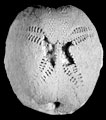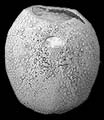The Echinoid Directory
Blaviaster Lambert, 1920, p. 26
[=Temnaster Lambert, 1912, p. 106; non Verril, 1894]
| Diagnostic Features |
|
|---|---|
| Distribution | Eocene (Lutetian) of Blaye, France; Eocene (undifferentiated), Iraq. |
| Name gender | masculine |
| Type | Temnaster grossouvrei, Lambert, 1912, p. 63, by original designation. |
| Species Included |
|
| Classification and/or Status |
|
| Remarks | Supposedly differs from Gualtieria in having the peripetalous fasciole passing through the petals close to their end rather than at mid-length, and in lacking the strong tubercles on the basicoronal interambulacral plates surrounding the mouth. The distinction between the two seems very slight. |





